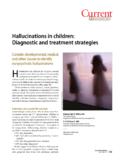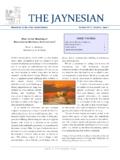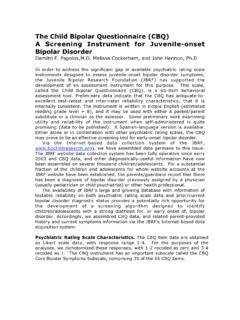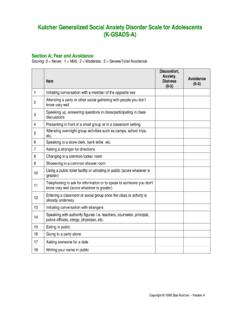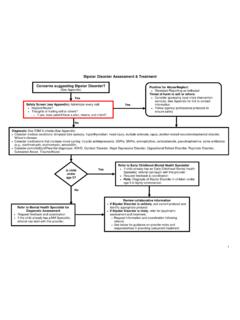Transcription of Hallucinations in children: Diagnostic and treatment ...
1 Current PsychiatryVol. 9, No. 1053 Hallucinations in children are of grave concern to parents and clinicians, but aren t necessarily a symptom of mental illness. In adults, halluci-nations usually are linked to serious psychopathology; however, in children they are not uncommon and may be part of normal development (Box, page 54). A hallucination is a false auditory, visual, gustatory, tactile, or olfactory perception not associated with real external It must be differentiated from similar phenomenon such as illusions (misperception of actual stimuli), elaborate fantasies, imaginary companions, and eidetic images (visual images stored in memory). Common, yet a cause for concernEpidemiologic studies show of adults report hal-lucinations before age Nonpsychotic children as young as age 5 have reported Halluci-natory phenomenon may be present in 8% to 21% of all 11-year-old children .
2 Two-thirds of these patients have no DSM-IV-TR ,5 However, 1 evaluation of 62 nonpsychotic hallucinating children treated in a psychiatric emergency department (ED): 34% had depression 22% had attention-deficit/hyperactivity disorder (ADHD) 21% had disruptive behavior disorders 23% had other Studies suggest that children who have Hallucinations but no other psychotic symptoms have a better long-term prognosis than those with additional psychotic Consider developmental, medical, and other causes to identify nonpsychotic Hallucinations Hallucinations in children : Diagnostic and treatment strategiesKanwar Ajit S. Sidhu, MDAssistant professorDepartment of behavior medicine and psychiatry T. O. Dickey III, MDAssociate professor and program directorDepartment of behavior medicine and psychiatry West Virginia University Charleston, WV KATHY PsychiatryOctober 201054 Hallucinations in childrenVisit this article at for a bibliography of childhood Hallucinations literatureONLINE A 17-year longitudinal study of children with Hallucinations and concurrent emotional and conduct problems found.
3 Up to 50% of patients still experience Hallucinations at age 30 Hallucinations did not significantly predict clinical outcome at age 30 childhood Hallucinations did not in-crease the risk for psychosis, depression, organic brain disorder, or other psychiatric In a study of children with psychosis and disruptive disorders , at 2- to 8-years follow-up 50% met criteria for major de-pressive disorder, bipolar disorder, or schizophreniform In a 15-year longitudinal study of 11-year-olds, self-reported psychotic symptoms such as delusional beliefs and hallucinatory expe-riences predicted a high risk of schizo-phreniform disorder at age These studies suggest that experiencing signifi-cant disruptions in thoughts and percep-tions during childhood may be related to later development of prominent mood and thought diagnosisTable 1 lists possible causes of hallucina-tion in ,10-13 Hallucinations during childhood can occur in the context of sev-eral psychiatric disorders , including: schizophrenia schizophreniform disorders mood disorders with psychotic fea-tures (Table 2).
4 14 They can also manifest as comorbid or associated symptoms of disorders not commonly associated with Hallucinations , such as ADHD, disruptive disorders , anxiety disorders , and prodromal clinical states. Medications, substance use, and or-ganic and metabolic disorders also must Clinical PointStudies suggest that children who have Hallucinations but no other psychotic symptoms have a better long-term prognosisNormal developmentNonpsychotic psychopathologyPsychosocial adversityPsychotic illnessStressFamily dysfunction DeprivationDevelopmental difficultiesSociocultural interaction (immigration)Poorly differentiated male and female family rolesPresence or absence of different mother figuresCultural factors (witches, ghosts, spiritualism)Hallucination of deceased parent, when unresolved mourning persists in the surviving parentSource.
5 References 6,10-13 Possible causes of Hallucinations in children and adolescents Table 1In children , Hallucinations are not always a sign of psychosisBoxAlthough Hallucinations frequently are considered synonymous with psychotic disorders , in children this rare. Neurobiologic studies (fMRI) of adults show activation of Broca s area (left inferior frontal gyrus) seconds before patients perceive auditory verbal Hallucinations , which suggests that auditory Hallucinations may be misidentified ,b According to Piaget,c children age <7 may have difficulty distinguishing between events occurring while dreaming and awake. He further theorized that nonpathologic Hallucinations could become pathologic when combined with trauma such as abuse. Straussd suggested that psychosis might lie on a continuum with normal phenomenon. In a case series, Wilking and Paulie described how developmental difficulties, deprivation, sociocultural conditions, and family relationships could contribute to impaired reality testing.
6 Imaginary friends or companions are common among all children . children who have imaginary friends are more likely to report hearing voices. f Imaginary friends: appear, function, and disappear at the wish of the child pose no threat and often are a source of comfort often can be described in detail are not , children with imaginary friends will not show evidence of a thought : For reference citations, see this article at considered in the differential diagnosis (Table 3, page 56). Hallucinations may occur in low-func-tioning or anxious children , in the context of psychosocial adversity or abuse, and during bereavement of a deceased parent when the surviving parent is emotionally ,15-17 Rule out hypnagogic and hypnopompic Hallucinations , which are predominantly visual Hallucinations that occur immediately before falling asleep and during the transition from sleep Clinical PointChildren with language disorders may talk about voices because they cannot describe their own thoughtsSchizophrenia or other psychotic disordersMay hear several voices making a critical commentaryCommand Hallucinations telling patients to harm themselves or othersBizarre voices like a computer in my head or aliensVoices of someone familiar or a relative Visual Hallucinations of devils, scary faces, space creatures.
7 And skeletonsDepressive disordersUsually a single voice speaking from outside the patient s head with derogatory or suicidal contentBipolar disorderUsually involves grandiose ideas about power, worth, knowledge, family, or relationshipBereavementUsually a transient (visual or auditory) perception of the deceased personPosttraumatic stress disorderTransient visual Hallucinations , usually with phobic contentSource: Reference 11 Content of Hallucinations may point to their causeTable 2 Evaluate the controversies and recent clinical studies in the biology, diagnosis, and treatment of bipolar disorder. Integrate key points into your clinical practice! This supplement addresses the fine line that sometimes separates clinical assumptions from systematically acquired medical activity is hosted by the University of Minnesota and Consensus Medical Communications and is supported by an educational grant from Janssen, This grant is administered by Ortho-McNeil Janssen Scientific Affairs, CME creditsAvailable at PROCEEDINGS AND DATA FROM THE bipolar SUMMIT A new CME activity from Current PsyChiatryLEARN FROM THE EXPERTSS tephen M.
8 Strakowski, MDUniversity of Cincinnati College of MedicineCincinnati, Ohio Melissa P. DelBello, MD, MSUniversity of Cincinnati College of MedicineCincinnati, OhioKiki Chang, MDStanford University School of MedicineStanford, CaliforniaJoseph F. Goldberg, MDMount Sinai School of MedicineNew York, New YorkLori Altshuler, MDDavid Geffen School of Medicine at UCLALos Angeles, CaliforniaMichael Ostacher, MD, MPHH arvard Medical SchoolBoston, MassachusettsS. Charles Schulz, MDUniversity of Minnesota Medical SchoolMinneapolis, MinnesotaCurrent PsychiatryOctober 201056 Hallucinations in childrento wakefulness, Rarely, a child who has had Hallucinations for some time may learn to complain of them when he or she is not hallucinating in order to obtain a primary or secondary gain, such as getting attention from caregivers.
9 Little is known about psychosis and Hallucinations in preschoolers (age 5); therefore, their language use may help as-sessment. Because of cognitive immaturity, children often use illogical thinking and loose association and may describe their thoughts as voices. This is common in children with language disorders and sometimes in healthy patients who may talk about voices because they cannot de-scribe their own thoughts. children with ADHD and/or opposition-al defiant disorder often are impulsive and show poor judgment and may blame voices for telling them to do bad things. These hal-lucinations may represent internal thoughts battling with the child s Audi-tory and visual Hallucinations have been re-ported in children with Tourette syndrome, especially when associated with ADHD or obsessive-compulsive causes.
10 Electrolyte disturbances, metabolic disorders , fever, and serious in-fections are common nonpsychiatric causes of Brain neoplasm partic-ularly in visual association areas, the tem-poral lobe, or portions of the optic nerve or retina also may produce Hallucinations , which can be complex with full such as steroids and an-ticholinergics may cause Hallucinations . Case studies report visual and tactile hal-lucinations with methylphenidate therapy that resolve after discontinuing the Illicit substances, including cannabis, lysergic acid diethylamide (LSD), cocaine, amphetamines, 3,4-methylenedioxymeth-amphetamine (ecstasy), opiates, and barbi-turates, can induce substance-induced hallucina-tions if your patient shows: acute onset of Hallucinations dilated pupils extreme agitation or drowsiness other signs of caused by seizure dis-orders are rare but can be somatosensory, visual (occipital lobe focus), auditory, olfactory (uncinate, complex partial), or gustatory.
